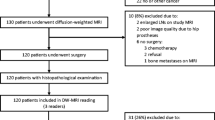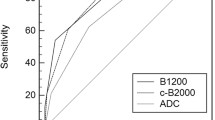Abstract
Objectives
To investigate the usefulness of Apparent Diffusion Coefficients (ADC) in predicting prostatectomy Gleason Grades (pGG) and Scores (GS), compared with ultrasound-guided biopsy Gleason Grades (bGG).
Methods
Twenty-four patients with biopsy-proven prostate cancer were included in the study. Diffusion-weighted images were obtained using 1.5-T MR with a pelvic phased-array coil. Median ADC values (b0,500,1000 s/mm²) were measured at the most suspicious areas in the peripheral zone. The relationship between ADC values and pGG or GS was assessed using Pearson’s coefficient. The relationship between bGG and pGG or GS was also evaluated. Receiver operating characteristic (ROC) curve analysis was performed to assess the performance of each method on a qualitative level.
Results
A significant negative correlation was found between mean ADCs of suspicious lesions and their pGG (r = −0.55; p < 0.01) and GS (r = −0.63; p < 0.01). No significant correlation was found between bGG and pGG (r = 0.042; p > 0.05) or GS (r = 0.048; p > 0.05). ROC analysis revealed a discriminatory performance of AUC = 0.82 for ADC and AUC = 0.46 for bGG in discerning low-grade from intermediate/high-grade lesions.
Conclusions
The ADC values of suspicious areas in the peripheral zone perform better than bGG in the correlation with prostate cancer aggressiveness, although with considerable intra-subject heterogeneity.
Key Points
• Prostate cancer aggressiveness is probably underestimated and undersampled by routine ultrasound-guided biopsies.
• Diffusion-weighted MR images show good linear correlation with prostate cancer aggressiveness.
• DWI information may be used to improve risk-assessment in prostate cancer.



Similar content being viewed by others
References
Society AC (2009) Cancer facts and figures 2009. Available at http://www.cancer.org/Research/CancerFactsFigures/cancer-facts-figures-2009. Accessed September 1, 2011
Bill-Axelson A, Holmberg L, Ruutu M et al (2005) Radical prostatectomy versus watchful waiting in early prostate cancer. N Engl J Med 352:1977
D'Amico AV, Whittington R, Malkowicz SB et al (1998) Biochemical outcome after radical prostatectomy, external beam radiation therapy, or interstitial radiation therapy for clinically localized prostate cancer. Jama 280:969
Partin AW, Mangold LA, Lamm DM, Walsh PC, Epstein JI, Pearson JD (2001) Contemporary update of prostate cancer staging nomograms (Partin Tables) for the new millennium. Urology 58:843–848
D’Amico AV, Moul J, Carroll PR, Sun L, Lubeck D, Chen MH (2003) Cancer-specific mortality after surgery or radiation for patients with clinically localized prostate cancer managed during the prostate-specific antigen era. J Clin Oncol 21:2163
Stephenson AJ, Scardino PT, Eastham JA et al (2005) Postoperative nomogram predicting the 10-year probability of prostate cancer recurrence after radical prostatectomy. J Clin Oncol 23:7005
Gleason DF, Mellinger GT (1974) the Veterans administration cooperative urological research group: prediction of prognosis for prostatic adenocarcinoma by combined histological grading and clinical staging(ed)^(eds), pp 58–64
Epstein J, Allsbrook W Jr, Amin M, Egevad L (2005) The 2005 International Society of Urological Pathology (ISUP) consensus conference on Gleason grading of prostatic carcinoma. Am J Surg Pathol 29:1228
Blute M, Bergstralh E, Iocca A, Scherer B, Zincke H (2001) Use of Gleason score, prostate specific antigen, seminal vesicle and margin status to predict biochemical failure after radical prostatectomy. J Urol 165:119
Egevad L, Granfors T, Karlberg L, Bergh A, Stattin P (2002) Percent Gleason grade 4/5 as prognostic factor in prostate cancer diagnosed at transurethral resection. J Urol 168:509–513
Cohen M, Hanley R, Kurteva T et al (2008) Comparing the Gleason prostate biopsy and Gleason prostatectomy grading system: the Lahey Clinic Medical Center experience and an international meta-analysis. Eur Urol 54:371–381
Kvåle R, Møller B, Wahlqvist R et al (2009) Concordance between Gleason scores of needle biopsies and radical prostatectomy specimens: a population-based study. BJU Int 103:1647–1654
Rajinikanth A, Manoharan M, Soloway CT, Civantos FJ, Soloway MS (2008) Trends in Gleason score: concordance between biopsy and prostatectomy over 15 years. Urology 72:177–182
Stav K, Merald H, Leibovici D, Lindner A, Zisman A (2007) Does prostate biopsy Gleason score accurately express the biologic features of prostate cancer?(ed)^(eds). Elsevier, pp 383–386
Neil JJ (1997) Measurement of water motion (apparent diffusion) in biological systems. Concepts Magn Reson 9:385–401
Pagani E, Bizzi A, Di Salle F, De Stefano N, Filippi M (2008) Basic concepts of advanced MRI techniques. Neurol Sci 29:290–295
Qayyum A (2009) Diffusion-weighted imaging in the abdomen and pelvis: concepts and applications. Radiographics 29:1797–1810
Guo Y, Cai YQ, Cai ZL et al (2002) Differentiation of clinically benign and malignant breast lesions using diffusion weighted imaging. J Magn Reson Imaging 16(2):172–178
Pereira FPA, Martins G, Figueiredo E et al (2009) Assessment of breast lesions with diffusion-weighted MRI: comparing the use of different b values. Am J Roentgenol 193:1030
Sugahara T, Korogi Y, Kochi M et al (1999) Usefulness of diffusion-weighted MRI with echo-planar technique in the evaluation of cellularity in gliomas. J Magn Reson Imaging 9:53–60
de Souza NM, Reinsberg SA, Scurr ED, Brewster JM, Payne GS (2007) Magnetic resonance imaging in prostate cancer: the value of apparent diffusion coefficients for identifying malignant nodules. Br J Radiol 80:90–95. doi:10.1259/bjr/24232319
Hosseinzadeh K, Schwarz SD (2004) Endorectal diffusion weighted imaging in prostate cancer to differentiate malignant and benign peripheral zone tissue. J Magn Reson Imaging 20:654–661
Issa B (2002) In vivo measurement of the apparent diffusion coefficient in normal and malignant prostatic tissues using echo planar imaging. J Magn Reson Imaging 16:196–200
Pickles MD, Gibbs P, Sreenivas M, Turnbull LW (2006) Diffusion weighted imaging of normal and malignant prostate tissue at 3.0T. J Magn Reson Imaging 23:130–134
Sato C, Naganawa S, Nakamura T et al (2005) Differentiation of noncancerous tissue and cancer lesions by apparent diffusion coefficient values in transition and peripheral zones of the prostate. J Magn Reson Imaging 21:258–262
Tanimoto A, Nakashima J, Kohno H, Shinmoto H, Kuribayashi S (2007) Prostate cancer screening: the clinical value of diffusion weighted imaging and dynamic MR imaging in combination with T2 weighted imaging. J Magn Reson Imaging 25:146–152
Xu J, Humphrey PA, Kibel AS et al (2009) Magnetic resonance diffusion characteristics of histologically defined prostate cancer in humans. Magn Reson Med 61:842–850
Padhani AR, Liu G, Mu-Koh D et al (2009) Diffusion-weighted magnetic resonance imaging as a cancer biomarker: consensus and recommendations. Neoplasia (New York, NY) 11:102
DeSouza N, Riches S, Vanas N et al (2008) Diffusion-weighted magnetic resonance imaging: a potential non-invasive marker of tumour aggressiveness in localized prostate cancer. Clin Radiol 63:774–782
Itou Y, Nakanishi K, Narumi Y, Nishizawa Y, Tsukuma H (2011) Clinical utility of apparent diffusion coefficient (ADC) values in patients with prostate cancer: can ADC values contribute to assess the aggressiveness of prostate cancer? J Magn Reson Imaging 33:167–172
Tamada T, Sone T, Jo Y et al (2008) Apparent diffusion coefficient values in peripheral and transition zones of the prostate: comparison between normal and malignant prostatic tissues and correlation with histologic grade. J Magn Reson Imaging 28:720–726
Turkbey B, Shah VP, Pang Y et al (2011) Is apparent diffusion coefficient associated with clinical risk scores for prostate cancers that are visible on 3-T MR images? Radiology 258:488–495
Verma S, Rajesh A, Morales H et al (2011) Assessment of aggressiveness of prostate cancer: correlation of apparent diffusion coefficient with histologic grade after radical prostatectomy. Am J Roentgenol 196:374
Woodfield CA, Tung GA, Grand DJ, Pezzullo JA, Machan JT, Renzulli JF (2010) Diffusion-weighted MRI of peripheral zone prostate cancer: comparison of tumor apparent diffusion coefficient with Gleason score and percentage of tumor on core biopsy. Am J Roentgenol 194:W316
Epstein JI, Srigley J, Grignon D, Humphrey P (2007) Recommendations for the reporting of prostate carcinoma. Hum Pathol 38:1305–1309
Graser A, Heuck A, Sommer B et al (2007) Per-sextant localization and staging of prostate cancer: correlation of imaging findings with whole-mount step section histopathology. Am J Roentgenol 188:84
Chenevert TL, Sundgren PC, Ross BD (2006) Diffusion imaging: insight to cell status and cytoarchitecture. Neuroimaging Clin N Am 16:619
San Francisco I, DeWOLF W, Rosen S, Upton M, Olumi A (2003) Extended prostate needle biopsy improves concordance of Gleason grading between prostate needle biopsy and radical prostatectomy. J Urol 169:136–140
Smith JJA, Scardino PT, Resnick MI, Hernandez AD, Rose SC, Egger MJ (1997) Transrectal ultrasound versus digital rectal examination for the staging of carcinoma of the prostate: results of a prospective, multi-institutional trial. J Urol 157:902–906. doi:10.1016/s0022-5347(01)65079-1
Norberg M, Egevad L, Holmberg L, Sparén P, Norlén BJ, Busch C (1997) The sextant protocol for ultrasound-guided core biopsies of the prostate underestimates the presence of cancer. Urology 50:562–566. doi:10.1016/s0090-4295(97)00306-3
Xu S, Kruecker J, Turkbey B et al (2008) Real-time MRI-TRUS fusion for guidance of targeted prostate biopsies. Comput Aided Surg 13:255–264
Hambrock T, Futterer JJ, Huisman HJ et al (2008) Thirty-two-channel coil 3T magnetic resonance-guided biopsies of prostate tumor suspicious regions identified on multimodality 3T magnetic resonance imaging: technique and feasibility. Invest Radiol 43:686–694
Hambrock T, Somford DM, Hoeks C et al (2010) Magnetic resonance imaging guided prostate biopsy in men with repeat negative biopsies and increased prostate specific antigen. J Urol 183(2):520–527. doi:10.1016/j.juro.2009.10.022
Wang L, Hricak H, Kattan MW et al (2007) Prediction of seminal vesicle invasion in prostate cancer: incremental value of adding endorectal mr imaging to the kattan nomogram1. Radiology 242:182–188
Author information
Authors and Affiliations
Corresponding author
Rights and permissions
About this article
Cite this article
Bittencourt, L.K., Barentsz, J.O., de Miranda, L.C.D. et al. Prostate MRI: diffusion-weighted imaging at 1.5T correlates better with prostatectomy Gleason grades than TRUS-guided biopsies in peripheral zone tumours. Eur Radiol 22, 468–475 (2012). https://doi.org/10.1007/s00330-011-2269-1
Received:
Revised:
Accepted:
Published:
Issue Date:
DOI: https://doi.org/10.1007/s00330-011-2269-1




